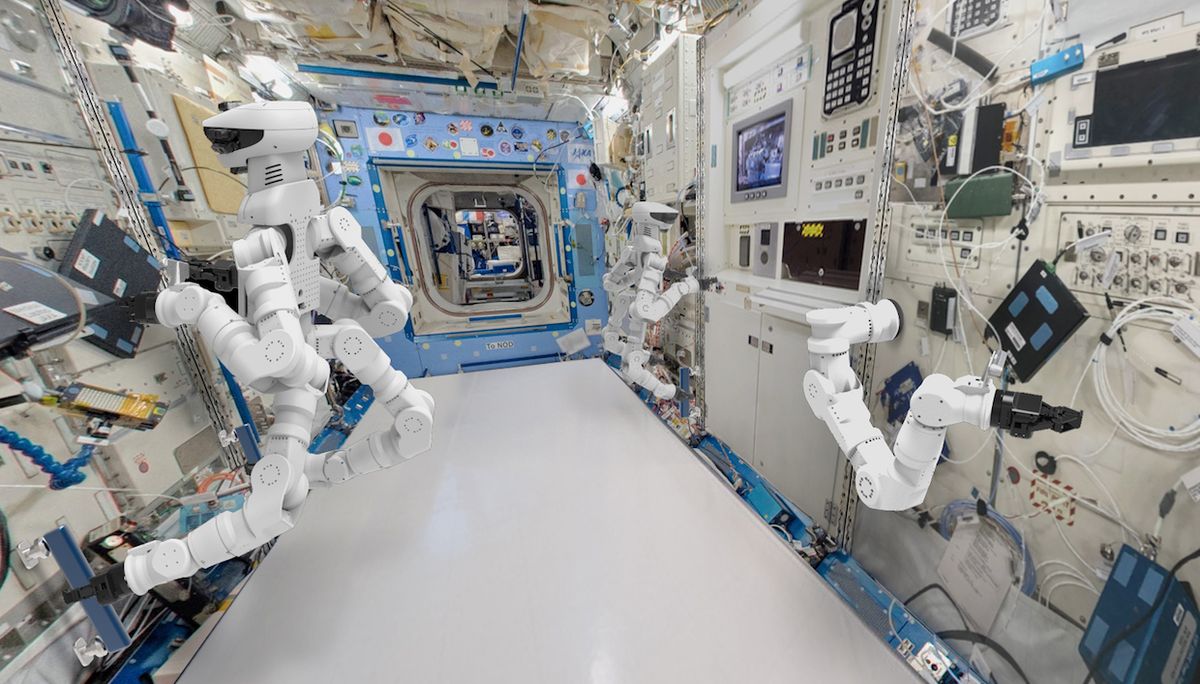We’ve been keeping a close watch on GITAI since early last year—what caught our interest initially is the history of the company, which includes a bunch of folks who started in the JSK Lab at the University of Tokyo, won the DARPA Robotics Challenge Trials as SCHAFT, got swallowed by Google, narrowly avoided being swallowed by SoftBank, and are now designing robots that can work in space.
The GITAI YouTube channel has kept us more to less up to date on their progress so far, and GITAI has recently announced the next step in this effort: The deployment of one of their robots on board the International Space Station in 2021.

GITAI has been working on a variety of robots for space operations, the most sophisticated of which is a humanoid torso called G1, which is controlled through an immersive telepresence system. What will be launching into space next year is a more task-specific system called the S1, which is an 8-degrees-of-freedom arm with an integrated sensing and computing system that can be wall-mounted and has a 1-meter reach.
The S1 will be living on board a commercially funded, pressurized airlock-extension module called Bishop, developed by NanoRacks. Mounted on the inside of the Bishop module, the S1 will have access to a task board and a small assembly area, where it will demonstrate common crew intra-vehicular activity, or IVA—tasks like flipping switches, turning knobs, and managing cables. It’ll also do some in-space assembly, or ISA, attaching panels to create a solar array.
Here’s a demonstration of some task board activities, conducted on Earth in a mockup of Bishop:
GITAI says that “all operations conducted by the S1 GITAI robotic arm will be autonomous, followed by some teleoperations from Nanoracks’ in-house mission control.” This is interesting, because from what we’ve seen until now, GITAI has had a heavy emphasis on telepresence, with a human in the loop to get stuff done. As GITAI’s founder and CEO Sho Nakanose commented to us a year ago, “Telepresence robots have far better performance and can be made practical much quicker than autonomous robots, so first we are working on making telepresence robots practical.”
So what’s changed? “GITAI has been concentrating on teleoperations to demonstrate the dexterity of our robot, but now it’s time to show our capabilities to do the same this time with autonomy,” Nakanose told us last week. “In an environment with minimum communication latency, it would be preferable to operate a robot more with teleoperations to enhance the capability of the robot, since with the current technology level of AI, what a robot can do autonomously is very limited. However, in an environment where the latency becomes noticeable, it would become more efficient to have a mixture of autonomy and teleoperations depending on the application. Eventually, in an ideal world, a robot will operate almost fully autonomously with minimum human cognizance.”
Nakanose says that this mission will help GITAI to “acquire the skills, know-how, and experience necessary to prepare a robot to be ISS compatible, prov[ing] the maturity of our technology in the microgravity environment.” Success would mean conducting both IVA and ISA experiments as planned (autonomous and teleop for IVA, fully autonomous for ISA), which would be pretty awesome, but we’re told that GITAI has already received a research and development order for space robots from a private space company, and Nakanose expects that “by the mid-2020s, we will be able to show GITAI's robots working in space on an actual mission.”
NanoRacks is schedule to launch the Bishop module on SpaceX CRS-21 in November. The S1 will be launched separately in 2021, and a NASA astronaut will install the robot and then leave it alone to let it start demonstrating how work in space can be made both safer and cheaper once the humans have gotten out of the way.
Evan Ackerman is a senior editor at IEEE Spectrum. Since 2007, he has written over 6,000 articles on robotics and technology. He has a degree in Martian geology and is excellent at playing bagpipes.



